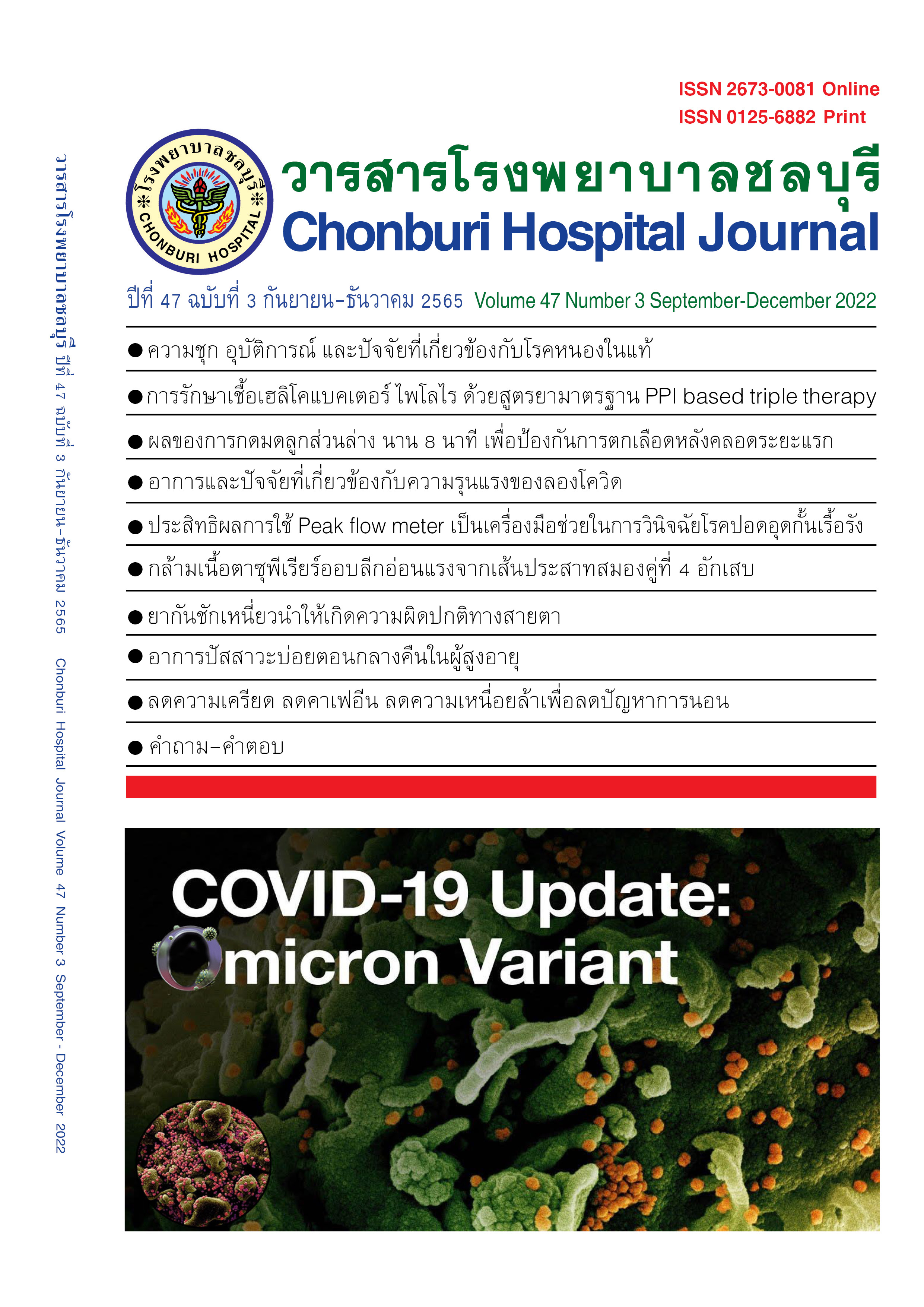The Outcome of Lower Uterine Segment Compression for 8 minutes at Nakhonnayok Hospital in Normal Vaginal Delivery to Prevent Early Postpartum Hemorrhage
Abstract
The objective of this experimental research was to determine the outcome and amount of blood loss between the lower uterine segment compression for 8 minutes method and the conventional treatment in normal vaginal delivery. The present study was done at Department of Obstetrics and Gynecology in Nakhonnayok Hospital between June and October 2021. All subjects had a singleton pregnancy with a gestational age between 37-42 week and no past medical history. Cases with polyhydramnios or treated with magnesium sulfate or complications comprising uterine inversion or rupture, hematoma or severe laceration of birth canal, retained placenta were excluded. The purposive sampling was devided into two groups, the experimental group and the control group. Mothers in both experimental and control group were treated with the same method, oxytocin administration, clamping and cutting umbilical cords within three minutes after birth of the newborns, and placental delivery was done by controlled cord traction together with uterine massage at the fundus, through the abdominal wall immediately, In addition, in the experimental group, the subjects were assisted by lower uterine segment compression for 8 minutes. The amount of blood loss in both control and experimental group were collected within a 2 hour postpartum period. The results revealed that the experimental group had a significantly lower mean of blood loss in the third stage and the fourth stage of labor than the control group (256.93 ± 95.63 ml. vs 216.07 ± 76.00 ml., P = .002 in the third stage and 63.67 ± 15.74 ml. vs 57.50 ± 12.41 ml., P = .004 in the fourth stage). It was found that lower uterine segment compression could reduce significantly the incidence rate of early postpartum hemorrhage (5.7% vs 1.1%, P = .006) There finding suggested that the lower uterine segment compression immediately after placental delivery for 8 minutes could reduce the rate of early postpartum hemorrhage and amount of blood loss after normal vaginal delivery. The efficacy of this technique was over the conventional method. Beside, Lower uterine segment compression was easy and safe. Neither anesthesia nor extra-expense was needed
References
GBD 2015 Maternal Mortality Collaborators. Global, regional and national levels of maternal mortality, 1990-2015 : a systematic analysis for the Global Burden of Disease Study 2015. Lancet 2016;388(10053):1775-812.
กรมอนามัย กระทรวงสาธารณสุข. อัตราส่วนการตายมารดา [อินเทอร์เน็ต]. 2562 [เข้าถึงเมื่อ
มีนาคม 2562]. เข้าถึงจาก http://planning.anamai.moph.go.th/download/D_Strategic/2562/Committee/Committed62_Data2-050362.pdf
World Health Organization. WHO guidelines for the management of postpartum hemorrhage and retained placenta. France: WHO; 2014.
World Health Organization. WHO recommendations for the prevention and treatment of post partum hemorrhage. Italy: WHO; 2012.
Breathnach F, Geary M. Uterine atony : definition, prevention, non surgical management and uterine tamponade. Semin Perinatol 2009;33:82-7.
Gulmezoglu AM, Lumbiganon P, Landoulsi S, Widmer M, Abdul-Allem H, Festin M, et al. Active management of the third stage of labour with and without controlled cord traction: a randomized controlled, non-inferiority trial. Lancet 2012;379:1721-7.
Hofmeyr GJ, Mshweshwe NT, Gulmezoglu AH. Controlled cord traction for the third stage of labour. Cochrane Database Syst Rev [Internet]. 2015 [cited 2015 Jan 29]. Available from: https://doi.org/ 10.1002/14651858.CD008020.pub2
Chantrapitak W, Srijuntuek K, Wattanaluangarun R. The efficacy of lower uterine segment compression for prevention of early post partum hemorrhage after vaginal delivery. J Med Assoc Thai 2011;94(6):649-56.
Masuzawa Y, Yaeko K. Uterine activity during the two hours after placental delivery among low-risk pregnancies : an observational study. J Matern Fetal Neonatal Med 2017;30(20):2446-51.
Yuksel H. A novel approach to primary lower uterine segment atony. Taiwan J Obstet Gynecol 2015;54:452-4.
Estridge BM, Reynolds AP, Walters NJ. Basic hemostasis . In: Estridge BH, Reynolds AP, Walters NJ, editors. Basic medical laboratory techniques. 4th ed . New York: Delmar Cengage Learning; 2000. p. 235-72.
Poon CY. Clinical analysis. In: Troy DB, editor. Remington : the science and practice of phamacy. 21sted. Philadelphia: Lippincott Williams &Wilkins; 2005. p. 565–98.
Faul F, Erdfelder E, Buchner A, Lang AG. Statistical power analyses. using G* Power 3.1 : tests for correlation and regression analyses. Behav Res Meth 2009;41:1149-60.
Prendiville WJ, Elbourne D, McDonald S. Active versus expectant management in the third stage of labour. Cochrane Database Syst Rev [Internet]. 2009 [cited 2009 Jul 08]. Available from: https://
doi.org/10.1002/14651858.CD000007.pub2
Sekhavat L, Firuzabadi RD, Karimi ZM. Eftect of postpartum oxygen inhalation on vaginal blood loss. J Matern Fetal Neonatal Med 2009;22:1072-6.
Chantrapitak W, Anunsakunwat W, Sritippayawan S, Lojindarat S, Srijuntuek K, Wattanaluangarun R. Lower uterine segment compression (LUSC) procedure for treatment and prevention of postpartum hemorrhage. Charoenkrung Pracharak Hospital Journal 2014;10(1):45-52. (in Thai)
Downloads
Published
Versions
- 2023-01-05 (2)
- 2022-12-28 (1)
Issue
Section
License

This work is licensed under a Creative Commons Attribution-NonCommercial-NoDerivatives 4.0 International License.
บทความที่ได้รับการตีพิมพิ์เป็นลิขสิทธิ์ของวารสารโรงพยาบาลชลบุรี
